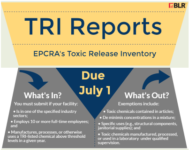“One year” is the operative time frame for managing universal wastes under the RCRA regulations at 40 CFR 273. All handlers of universal waste have one year to keep universal waste onsite. To prove that it meets this time limitation, the handler must be able to demonstrate the number of days the universal waste has […]
The Senate voted to pass a bill to reform the Toxic Substances Control Act (TSCA) Bill. The bill now goes to President Obama for his signature in order to become law. It’s the first time the Act has been amended in 40 years.
In a final interpretative rule, the EPA has streamlined the process whereby federally recognized tribes with reservations apply to the Agency to be treated in a manner similar to states (TAS) for the purposes of administering Clean Water Act (CWA) regulatory programs. The primary change under the interpretative rule is that tribes will no longer […]
Q. In an automobile dealership service department, can the floor (inside of a building) or oil/water separator drains be counted as secondary containment for containers ranging from 55 gallons (gals) to 500 gals?
On Tuesday, the U.S. Court of Appeals for the D.C. Circuit issued a brief order rescheduling the originally planned June 2, 2016, oral arguments in EPA’s Clean Power Plan (CPP) litigation (West Virginia v. EPA) to September 27, 2016. The order also noted that arguments would be heard by the en banc (full) court of […]
With is promulgation of standards to control emissions of methane from new, reconstructed, and modified sources in the oil and gas (O&G) sector, the Environmental Protection Agency (EPA) has taken a significant step toward meeting President Obama’s goal of cutting methane released by the entire sector by 40 to 45 percent by 2025.
BLR® has unveiled its newest podcast channel, EHS on Tap.
The TRI reporting deadline is approaching. This infographic provides essential information to help determine if you need to report.
Last summer, the U.S. Environmental Protection Agency (EPA) updated its underground storage tank (UST) regulations for the first time in over 2 decades. With this update, owners and operators of UST systems have additional compliance requirements—including new obligations for release detection.
With a new proposal, the EPA is seeking to introduce regulatory reforms intended to smooth over conflicts that have developed in the Agency’s relationship with states submitting state implementation plans (SIPs) to improve visibility in federal Class I areas as specified by Section 169A of the Clean Air Act (CAA). Most of the conflicts between […]










